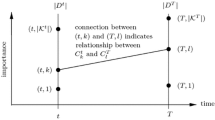Abstract
This article proposes text mining software to analyze FACT-Graph, and describes a case study using the software. FACT-Graph is a trend graph which visualizes what kinds of topic exist and shows the changes in trends in time-series text data. However, FACT-Graph itself does not have enough environments to analyze trends although it provides clues for a trend. In order to resolve this problem, we developed the software called Loopo. This software provides the functions of adding the considerations of the analyst as the keywords, and operating FACT-Graph itself such as moving, adding, and clearing nodes. The system also allows analysts to refer to an information source, keyword information, and network information in order to analyze and consider FACT-Graph. In a case study about criminal trends using the titles of newspaper articles between 1987 and 2007, we confirmed the usability of this software.
Similar content being viewed by others
References
Salton G (1989) Automatic text processing. Addison-Wesley, Reading
Harman D (1992) Ranking algorithms. Information retrieval, chap 14, Prentice Hall, Englewood Cliffs
Yamanishi K, Li H (2002) Mining open answers in questionnaire data. IEEE Intel Syst 17(5):58–64
Feldman R, Aumann Y, Zilberstein A, et al (1998) Trend graphs: visualizing the evolution of concept relationships in large document collections. 2nd European Symposium on Principles of Data Mining and Knowledge Discovery (PKDD 1998), pp 38–46
Havre S, Hetzler B, Nowell L (2002) ThemeRiver(TM): in search of trends, patterns, relationships. IEEE Trans Visualization Comput Graphics 8:9–20
Saga R, Terachi M, Tsuji H (2009) FACT-Graph: trend visualization by frequency and co-occurrence. IEEJ Trans Electron Inform Syst 129(3):545–552
Brachman R, Anand T (1996) The process of knowledge discovery in databases: a human-centered approach. A KDDM, AAAI/MIT Press, pp 37–58
Saga R, Terachi M, Sheng Z, et al (2008) FACT-Graph: trend visualization by frequency and co-occurrence. In: Lecture Notes on Artificial Intelligence (LNAI 5243, Dengel A et al (eds)), Springer, Berlin, Heidelberg, pp 308–315
Terachi M, Saga R, Tsuji H (2006) Trends recognition in journal papers by text mining. systems. Man Cybern (IEEE/SMC 2006), pp 4784–4789
Matsuo Y, Ohsawa Y, Ishizuka M (2002) Keyword extraction using small word structure in a document. Trans Inf Process Soc Jpn 43(6):1825–1833
Freeman LC (1979) Centrality in social networks: conceptual clarification. Soc Networks 1(3):215–239
Author information
Authors and Affiliations
Corresponding author
Additional information
This work was presented in part and was awarded the Best Paper Award at the 15th International Symposium on Artificial Life and Robotics, Oita, Japan, February 4–6, 2010
About this article
Cite this article
Saga, R., Tsuji, H., Miyamoto, T. et al. Development and case study of trend analysis software based on FACT-Graph. Artif Life Robotics 15, 234–238 (2010). https://doi.org/10.1007/s10015-010-0826-3
Received:
Accepted:
Published:
Issue Date:
DOI: https://doi.org/10.1007/s10015-010-0826-3




